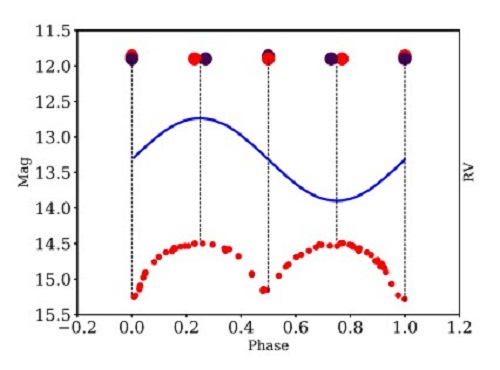Researchers Su-Su Shan, Fan Yang, and Ji-Feng Liu et al from National Astronomical Observatories of Chinese Academy of Sciences (NAOC) build a catalog of spectroscopic and eclipsing binaries. The catalog is the first one with sources identified as both spectroscopic and eclipsing binaries, taking advantage of observations from both the Large Sky Area Multi-Object Fiber Spectroscopic Telescope (LAMOST) and the Palomar Transient Factory (PTF) surveys. The result was recently published on The Astrophysical Journal Supplement on 2020 August 7.
Binary systems, common in stars, play important roles in, for example, determining stellar parameters, understanding the evolution of stars, measuring distances, and tracing black hole candidates. Binaries usually appear as a single point in images because of the distances involved. Some binary stars can be identified from optical spectra and are termed spectroscopic binaries (SB). Among all the binary stars, a very small fraction, closely aligned to the line of sight, are revealed as eclipsing, the so-called eclipsing binaries (EB). They allow us to derive the fundamental stellar parameters such as mass, radius, and luminosity. Thus, binary systems serve as test beds for stellar evolution theories.
Among all the binary star observations, the spectroscopic and eclipsing binaries provide the most comprehensive constraints on the binary parameters. Spectra tell us more about the observable stars, e.g. age, surface gravity, effective temperature, while the light curves are used to determine the orbital properties of the transit system (as shown in Figure 1).
However, among the identified spectroscopic binaries, the systems revealing eclipsing phenomena are rare. The journal reviewer added, “This itself is a noble cause, as such efforts for 'classical', dedicated observations of single stars would take years to reach the same results”. The catalog is based on the powerful spectra observations from LAMOST and thereby the enormous data sets.

Fig.1: Upper: orbital morphology of EB systems. Middle: The simulated radial velocity of the observable star. Lower: the light curve of the EB system, LPSEB71. (Credit: NAOC)
The catalog contains 88 spectroscopic and eclipsing binaries, among which 13 sources are newly identified as binaries. All the binaries have good quality light curves. The catalog contains orbital parameters, as well as the stellar parameters of the observable companion. The binaries in the catalog are mostly with a period of less than one day and show the 0.22 day cut-off in period distribution which supports the rareness of binary stars rotating with such a period.
This work provides the observations for the further research of binary star evolution. The researchers are also working on with LAMOST and ZTF (the upgrade of PTF) data, trying to find very short-period binary systems, which serves as a remarkable laboratory for General relativistic phenomena.

Fig.2: The periodograms (left column) and folded light curves (right column) of LPSEB59. (Credit: NAOC)
The paper can be accessed at https://iopscience.iop.org/article/10.3847/1538-4365/ab9b77

Address: 20A Datun Road, Chaoyang District, Beijing, China code: 100012
Tel: 010-64888708 E-mail: naoc@nao.cas.cn

